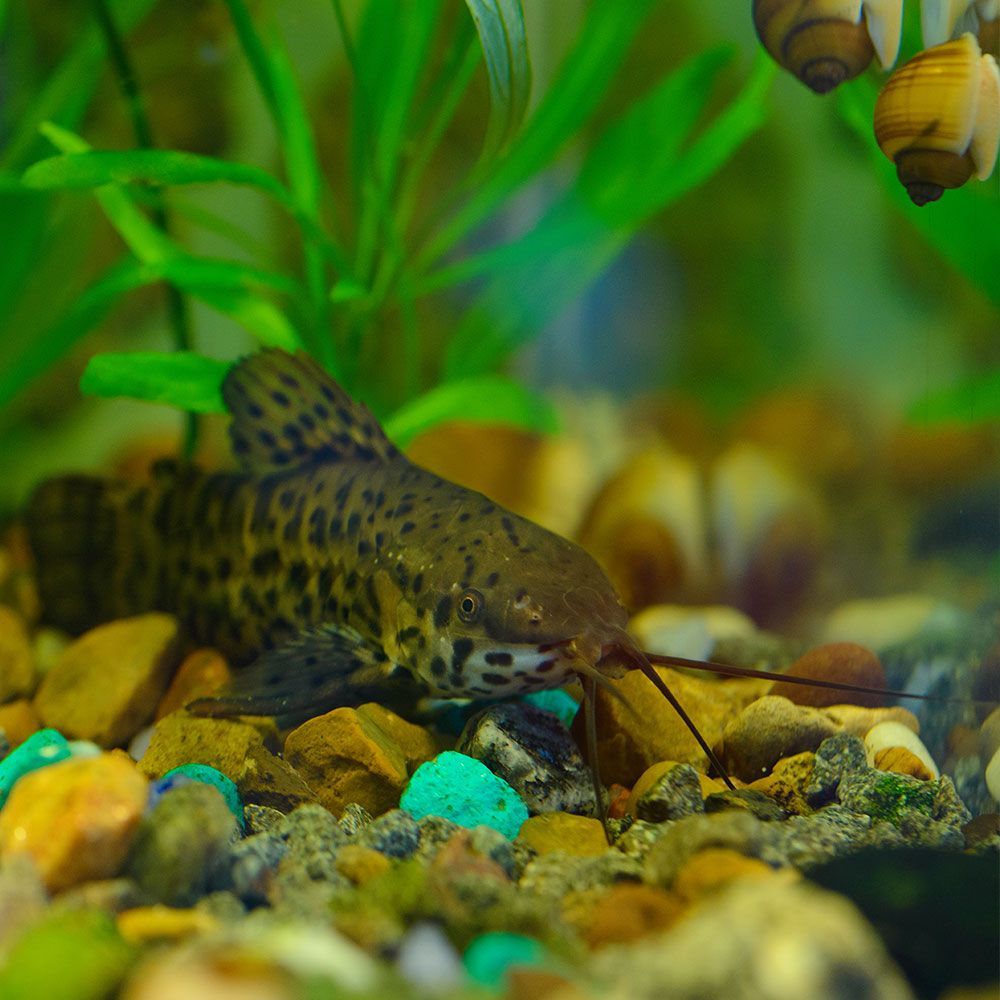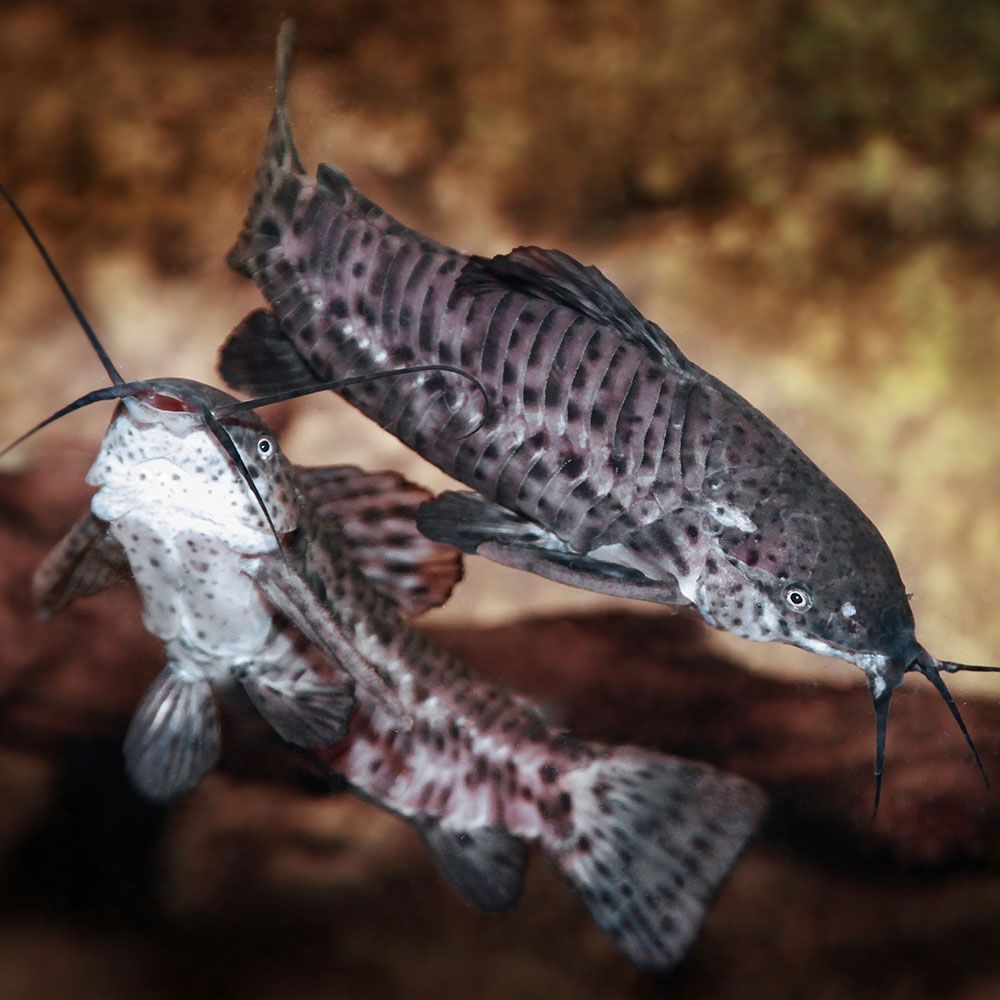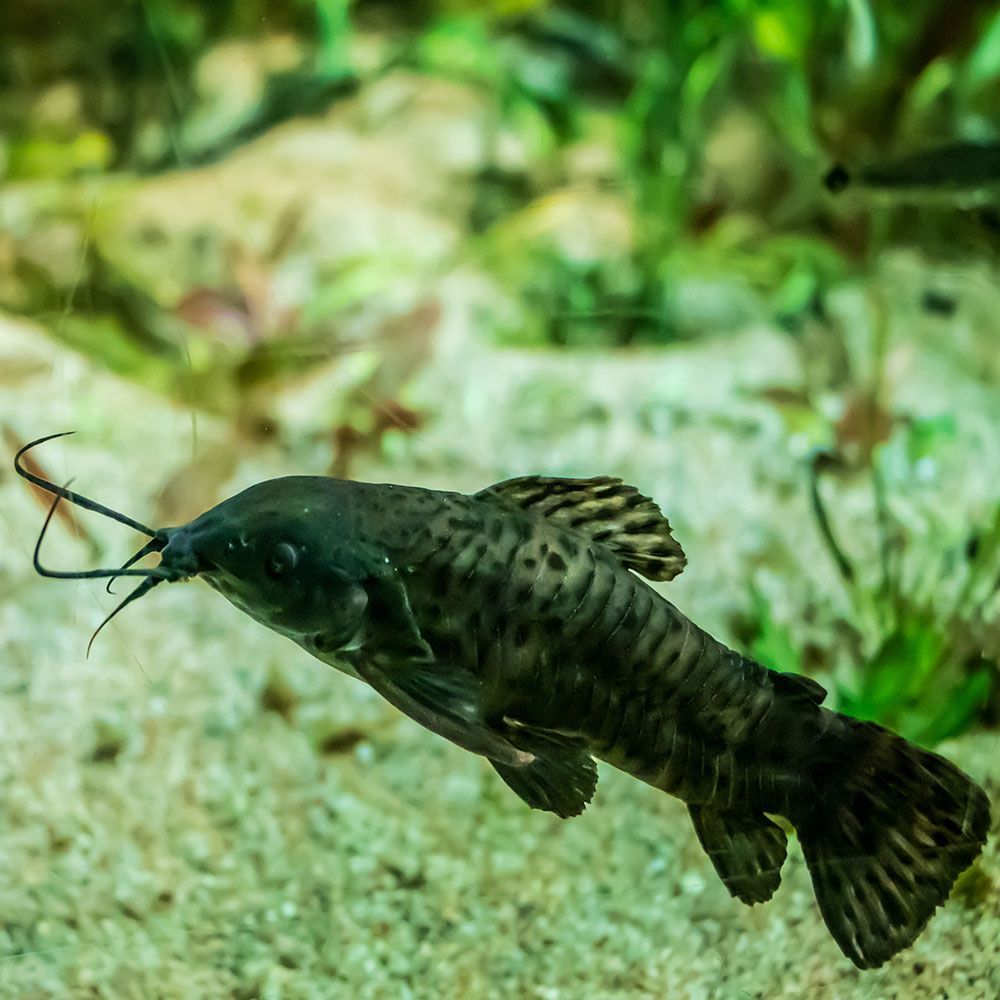Hoplo catfish has been a favorite among beginner freshwater aquarium enthusiasts. This is primarily because of their hardy nature, along with their unique spots and patterns.
Moreover, they can adjust to both – in dense communities and lone environments – which is an added advantage to beginners.
So, if you want to add one or more to your collection, keep reading!
What is Hoplo Catfish?
Hoplo catfish is a freshwater fish that is popular among the aquarium owners for its distinct patterns and spots on the body and its adjusting nature with different types of fish and environments.
| Origin | South America, Amazon, Orinoco, upper Paraguay river basin, coastal rivers of Northern Brazil, and Guianas |
| Order | Siluriformes |
| Family | Callichthyidae |
| Scientific Name | Megalechis thoracata |
| Common Names | Hoplo catfish, black marble hoplo, spotted hoplo |
| IUCN Red List Status | Not Evaluated |
| Appearance | Oblongated shape, brown color (or milky white if albino) with black non-geometric spots. |
| Size | 7.0-10.0 cm (2.5-4.0 in) |
| Maximum Body Weight | 140.00 g |
| Lifespan | 4-6 years in the wild, up to 10 years in captivity |
| Temperament | Peaceful, unless males guard the bubble nest |
| Tank Level | Demersal, Bottom dwellers |
| Water Temperature | 76-82 °F (24-28 °C) |
| pH Level | 6.0-8.0 |
| Water Hardness | Up to 2-15 dGH |
| Care Level | Easy to Intermediate |
| Minimum Tank Size | 25 gallons for one; minimum 55 gallons for a small group, but the larger, the better |
| Tank Environment | Spacious tank, dim lighting, hiding crevices, enough gap between tank lid and water surface |
| Diet | Omnivorous, anything that fits their mouth |
| Tank Mates | Large Rainbowfish species, large Devaro species, medium-sized species of barb family, medium-large sized Rasbora species, and medium-sized Tetra species. |
What is the Natural Habitat of Hoplo Catfish?
The fish is naturally found in the Amazon, Orinoco, and upper Paraguay River basins of South America. It thrives in slow-flowing and low-oxygen environments.
What is the Classification of Hoplo Catfish?
The scientific name of the species is Megalechis thoracata. It belongs to the Callichthyidae family under the order Siluriformes.
While its widely-known common name is hoplo catfish, it’s also known as black marble hoplo and spotted hoplo.
It is often misidentified as the brown hoplo (Hoplosternum littorale) and brown bullhead (Ameiurus nebulosus).
Fun Fact: They can survive in low-oxygen water pretty well as they can breathe atmospheric oxygen.
How do Hoplo Catfish look?

The fish is popular for its oblongated body, which is slightly flattened from the sides, and a wide head. Though there are far too many types of this species, let’s know more about the common ones.
What is the Size of Hoplo Catfish?
The adult fish can grow up to 15.5cm in the wild. In the aquarium trade, they are typically smaller, with adult sizes ranging from 7 to 10 cm (2.5 to 4 in) in length.and weigh at most 140.00g.
What is the Color of Hoplo Catfish?
Usually, the adult fish are dark brown, while the young fries are lightly pigmented. There are also non-geometric dark spots all over their body. Their abdomen is nearly white.
On the other hand, their albino species are milky white with dark spots all over them.
What are the Features of Hoplo Catfish?
The fish has:
- Two pairs of barbs on the upper jaw and one pair on the under-jaw
- Updrawn back
- Flat abdomen
- One fatty fin on the back
- Two rigid bony plates on the sides of the fish
They are known to breathe using their gills.
How do Hoplo Catfish male and female differ from each other?
The adult male hoplo catfish develop a thick orange, brown, or scarlet first pectoral fin ray. The fin ray is also covered in small hair. These features are completely absent in the female counterparts.
The adult female fish, on the other hand, has a fuller body.
How does Hoplo Catfish Behave in the tank?
They are usually one of the most peaceful fish types. But their temperament changes during the breeding season.
They enjoy living in at least a group of 5. However, a community isn’t necessary for their livelihood. They can be fine alone or as pairs.
However, during feeding time, multiple adult fish can become extremely aggressive out of hunger.
The fish is nocturnal, i.e., sleeps during the day and stays active at night.
What is the Lifespan of Hoplo Catfish?
This species can tolerate a lot of weather and environmental extremities. However, that reduces their lifespan a lot.
In their natural habitat, they live for about 4-6 years in the wild. However, if bred well in captivity with the right conditions, they can live up to 10 years.
Author’s Note: Hopla Catfish breathe via gastrointestinal respiration, i.e., the oxygen gets absorbed through their stomach and intestine lining.
How to take good care of Hoplo Catfish?
Although the fish is pretty hardy, they still have basic care requirements to survive until the optimum lifespan in captivity.
What is the Tank Size required for Hoplo Catfish?
For one adult fish, you need a minimum tank size of 25 gallons. However, since they are community fish, many hobbyists keep more than one fish together. In that case, a minimum of 55 gallons is a must.
What is the Water Chemistry needed for Hoplo Catfish?
To sustain your pet fish for the longest, you must maintain these water conditions:
- pH Levels: 6.0-8.0
- Water Temperature: 76-82 °F (24-28 °C)
- Water Hardness: up to 2-15 dGH
- Ammonia: 0 ppm
- Nitrite: 0 ppm
- Nitrate: < 30 ppm
What is the Tank Environment required for Hoplo Catfish?
This fish especially needs a mature tank, i.e., a stable and healthy environment with plenty of brown gunk in the filter.
What Substrate is needed for Hoplo Catfish?
The fish thrives better in soft sand substrate because they are bottom dwellers. In fact, they dig the substrate for food most of the time.
So, coarse or abrasive substrates might hurt and irritate the sensitive barbels of the fish to the point of making them fall off.
Note: Barbels are sensitive whisker-like organs of the fish right near its mouth, and it works as a sensory organ.
Which plants are needed for Hoplo Catfish?
They prefer enormous hiding places in their habitat. So, you can add various plants like Anubias, valisneria, java fern, and micranthemum. You can also add floating plants for more shelter while they swim about.
What type of Lighting is required for Hoplo Catfish?
They prefer low lighting in the tank for ease of hiding.
What Décor is needed for Hoplo Catfish?
They especially prefer to hide in rocky structures. So, you can also add driftwood, pipes, rock formations, or any other kind of crevices of appropriate size.
What type of Filtration is needed for Hoplo Catfish?
It’s always advised to maintain good water conditions and follow a healthy water change routine.
Install a canister filter to maintain a preferably clean and oxygenated water environment. You must also change 20% of the water weekly to avoid toxic nitrogen compound accumulation.
What is the Water Flow Rate required for Hoplo Catfish?
Though the fish is robust, it still prefers slow to moderate water flow rate.
Fish Care Tip: Since they come to the surface to inhale atmospheric oxygen, keep a good enough gap between the tank ceiling and the water surface.
What does Hoplo Catfish eat?
They are omnivorous and can feed on any edible fish feed that fits their mouth.
Some common dietary components are:
- Small or medium-sized worms, insects, and invertebrates
- Fish smaller than them
- Sinking frozen and prepared feed
- Mosquito larvae
- Brine shrimp
- Mysis shrimp
- Chopped krill
- Loose organic debris
It’s also recommended to feed them vegetable matter. Hoplo catfish species is extremely insatiable, so make sure you don’t overfeed them.
Initially, you can feed them better if you leave food near their hiding places. But once your pet fish gets used to you, they will become enthusiastic about meal time.
What are the Tank Mates for Hoplo Catfish?

This fish can be great tank mates with
- Other hoplo catfish (It can stay in a group of minimum 5 fish)
- Medium-sized species of barb family
- Medium-large-sized rasbora species
- Medium-sized tetra species (Black skirt tetra, Congo tetra, etc.)
- Large rainbowfish species
- Large devaro species
- Severum cichlid
- Betta fish
- Cardinal tetra
- Cherry barb
- Dwarf gourami
- Endler’s guppy
- Guppy
- Goldfish
- Glowlight tetra
- Harlequin rasbora
- Kuhli loach
Which Tank Mates to Avoid for Hoplo Catfish?
You must avoid keeping this species with:
- Any kind of smaller fish species that can fit in the holpo catfish’s mouth
- Or, any larger and slightly aggressive fish like:
- American cichlid
- African cichlid
- Larger catfish species
What are the most common diseases for Hoplo Catfish?
Many believe that this species doesn’t often fall sick easily because of its hardy nature. However, it’s better to keep an eye out and prevent these:
| Disease Name | Causes | Symptoms | Treatment |
|---|---|---|---|
| Columnaris | Bacterial Infection | Fin fraying, white/grey patches, appetite loss, lethargy. | Water quality improvement, stress reduction, and antibiotics. |
| Ich | Parasitic disease | Flashing, white spots, appetite loss, lethargy. | Temperature elevation, aquarium salt addition, and medicines. |
| Fin Rot | Bacterial Infection | Fin fraying or disintegration, fin discoloration or appearance of red streaks, appetite loss, lethargy. | Water quality improvement, removing possible objects that caused injury, antibiotics. |
Quick Tips
- They have a high tolerance for varied conditions. However, avoid exposing them to such situations as it’ll only make them sick and reduce their lifespan.
- Be vigilant while feeding as nervous fish doesn’t eat well. That can signify health issues.
- Sprinkle food at different locations if there are multiple fish in the tank so everyone gets enough nutrition.
How to Breed Hoplo Catfish in an aquarium?
Hoplo catfish are ready to reproduce when they are 1.5-2 years old. When they naturally form pairs, the male shows a bluish-purple tinge near its stomach which is a spawning sign
Remove other fish from the tank once a pair shows spawning signs to maintain a calm environment.
When the water surface shows minimal turbulence, the male prepares to form the bubble nest which is anchored to floating plants or polystyrene.
To further strengthen the nest, he adds more plant parts which he cuts with the sharp pectoral fins. This process takes place over multiple days.
What is the Mating Ritual of Hoplo Catfish?
After preparing the nest, the male fish courts the female fish. Once they agree to mate, they reach the bubble nest and take the T-position.
The female fish deposits a small number of her adhesive eggs at once and the male fertilizes them.
They repeat this process a few times until there are no more eggs left. Every female fish produces 150-500+ eggs depending on her size.
What happens in the Incubation Phase of Hoplo Catfish?
During this phase, the male guard the bubble nest and can be pretty aggressive. You must also remove the female fish as the males put their guard up even against their mate.
If any egg falls during this phase or the nest gets damaged, the male fish fetches the fallen eggs and does the necessary repairs.
When do Hoplo Catfish eggs hatch?
The eggs hatch after 72-96 hours. This is when you must also shift the male fish to another tank as it might prey on its fry.
The young fry receives nutrients from its yolk sac. However, you must still offer them microworms and brine shrimp after 24 hours.
Hoplo catfish fry can independently swim after 2 days of hatching and grow rapidly. Until the first 6-8 weeks, feed them in minute quantities. After this phase, the healthy fry grows to about 3.8cm.
Breeding Tip: Make sure to reduce surface water movement due to filtration before the bubble nest building.
A word from FishInAquarium
The medium-sized gorgeous hoplo catfish can be a great pet fish for all kinds of aquariums as they are peaceful and show peculiar behavior.
But if you have any questions, feel free to mail us. And, if you had fun learning about this fish, don’t forget to share it with other fish enthusiasts!


